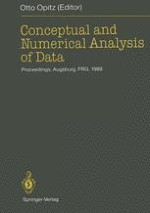1989 | OriginalPaper | Chapter
Symbolic Cluster Analysis
Authors : E. Diday, M. Paula Brito
Published in: Conceptual and Numerical Analysis of Data
Publisher: Springer Berlin Heidelberg
Included in: Professional Book Archive
Activate our intelligent search to find suitable subject content or patents.
Select sections of text to find matching patents with Artificial Intelligence. powered by
Select sections of text to find additional relevant content using AI-assisted search. powered by
The aim of this paper is to introduce the symbolic approach in data analysis and to show that it extends data analysis to more complex data which may be closer to the multidimensional reality. We introduce several kinds of symbolic objects (”events”, ”assertions”, and also ”hordes” and ”synthesis” objects) which are defined by a logical conjunction of properties concerning the variables. They can take for instance several values on a same variable and they are adapted to the case of missing and nonsense values. Background knowledge may be represented by hierarchical or pyramidal taxonomies. In clustering the problem remains to find inter-class structures such as partitions, hierarchies and pyramids on symbolic objects. Symbolic data analysis is conducted on several principles: accuracy of the representation, coherence between the kind of objects used at input and output, knowledge predominance for driving the algorithms, self-explanation of the results. We define order, union and intersection between symbolic objects and we conclude that they are organised according to an inheritance lattice. We study several properties and qualities of symbolic objects, of classes and of classifications of symbolic objects. Modal symbolic objects are then introduced. Finally, we present an algorithm to represent the clusters of a partition by modal assertions and obtain a locally optimal partition according to a given criterion.
